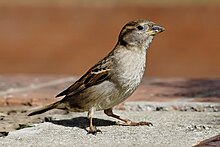Maniraptoriformes
| Maniraptoriformes Temporal range: Late Jurassic–Present, 167–0 Ma Possible Early Jurassic record |
|
|---|---|
 |
|
| Ornithomimid (Struthiomimus altus) fossil cast | |
 |
|
| House sparrow (Passer domesticus) | |
| Scientific classification | |
| Kingdom: | Animalia |
| Phylum: | Chordata |
| Class: | Reptilia |
| Clade: | Dinosauria |
| Order: | Saurischia |
| Suborder: | Theropoda |
| Clade: | Tyrannoraptora |
| Clade: |
Maniraptoriformes Holtz, 1995 |
| Subgroups | |
|
|
| Synonyms | |
Maniraptoriformes is a clade of dinosaurs with pennaceous feathers and wings that contains ornithomimosaurs and maniraptors. This group was named by Thomas Holtz, who defined it as "the most recent common ancestor of Ornithomimus and birds, and all descendants of that common ancestor."
Many fossils have been discovered in recent years, particularly in China. Many of the feathered dinosaurs belong to this clade. In particular, a fossil of the Alvarezsauridae Shuvuuia has a version of keratin consistent with that of avian feathers.
Many nearly complete fossil maniraptoriforms are known from the late Jurassic. Archaeopteryx is known from Bavaria at 155-150 Ma. Ornitholestes, the troodontid WDC DML 001, Coelurus fragilis and Tanycolagreus topwilsoni are all known from the Morrison Formation in Wyoming at about 150 Ma. The Daohugou biota, including Anchiornis and Epidexipteryx, is the earliest record of maniraptoriformes, dating to about 160 Ma. One possible maniraptoriform, Eshanosaurus, lived even earlier, during the Early Jurassic, though its identification is controversial.
The wide range of fossils in the early Cretaceous and morphological evidence suggests that the main branches of maniraptoriform differentiation were separate before the end of the Jurassic.
...
Wikipedia
